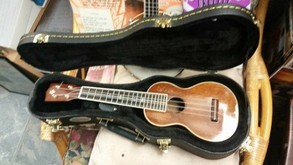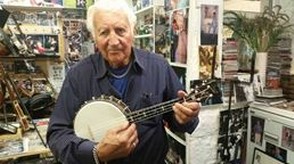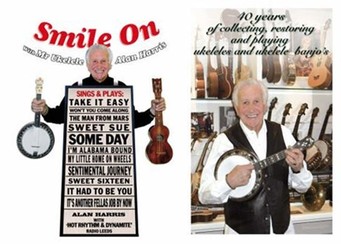 Member's Login
Member's Login
Feature - On The Case With "Mr Ukulele" Alan Harris
 Nestling in the beautiful Yorkshire countryside is one of the countries hidden gems: Alan Harris’
Ukulele Museum. It is a collection of the beautiful, the weird, and the wonderful, all
seen in the delightful company of Alan. Alan has music in his blood, as he grew up all
his family played: his dad played clarinet and Sax, his aunties all played ukulele, even
into their eighties. Alan still has his Uncle Stanley King’s Ludwig Crown, and what a beauty
it is too. Uncle Norman’s ukulele is something else entirely: it is made from a frying pan!
Norman used to play it in the pubs whilst away with work.
Nestling in the beautiful Yorkshire countryside is one of the countries hidden gems: Alan Harris’
Ukulele Museum. It is a collection of the beautiful, the weird, and the wonderful, all
seen in the delightful company of Alan. Alan has music in his blood, as he grew up all
his family played: his dad played clarinet and Sax, his aunties all played ukulele, even
into their eighties. Alan still has his Uncle Stanley King’s Ludwig Crown, and what a beauty
it is too. Uncle Norman’s ukulele is something else entirely: it is made from a frying pan!
Norman used to play it in the pubs whilst away with work.
 Right: Alan playing a Weetabix cigar box ukulele. Unlike a lot of cigar box instruments it
has a super tone, and plays really nicely. Alan often uses this to perform with as it is
such a visual surprise, and indeed played this instrument in the House of Commons when
his daughter Benita organised a Global Sharing day to raise awareness of the shared
creation, production, distribution, trade and consumption of goods and services by different
people and organisations.
Right: Alan playing a Weetabix cigar box ukulele. Unlike a lot of cigar box instruments it
has a super tone, and plays really nicely. Alan often uses this to perform with as it is
such a visual surprise, and indeed played this instrument in the House of Commons when
his daughter Benita organised a Global Sharing day to raise awareness of the shared
creation, production, distribution, trade and consumption of goods and services by different
people and organisations.
 One of the more unusual instruments is this 1920’s “Uke-a-phone”, right. When instruments were
originally recorded onto wax it was difficult to capture the sounds of violins and wooden ukuleles.
They were adapted to project the sound out through the horn. These instruments were played horn
towards the recording horn, and the sound was thus captured. It is a very 1920’s sound, very
evocative of the jazz age recordings, and was used extensively in vaudeville performances.
One of the more unusual instruments is this 1920’s “Uke-a-phone”, right. When instruments were
originally recorded onto wax it was difficult to capture the sounds of violins and wooden ukuleles.
They were adapted to project the sound out through the horn. These instruments were played horn
towards the recording horn, and the sound was thus captured. It is a very 1920’s sound, very
evocative of the jazz age recordings, and was used extensively in vaudeville performances.
 Right: Alan played a lovely pair of very unusual 1920’s Keech wooden ukuleles, a tenor, and
a soprano with the original booklet advertising it for sale. The tenor had the most beautiful warm
tone to it, with a crisp bright punch. Wooden Keeches are very rare nowadays, so to see two in
such beautiful condition was treat enough, and to be serenaded by Alan added to the experience greatly.
You can also make out one of Alan’s other unusual instruments in the picture. Alan’s museum is such
an interesting place to see, he has a hand-cranked Organola which plays “our Sergeant Major” amongst
other tunes!
Right: Alan played a lovely pair of very unusual 1920’s Keech wooden ukuleles, a tenor, and
a soprano with the original booklet advertising it for sale. The tenor had the most beautiful warm
tone to it, with a crisp bright punch. Wooden Keeches are very rare nowadays, so to see two in
such beautiful condition was treat enough, and to be serenaded by Alan added to the experience greatly.
You can also make out one of Alan’s other unusual instruments in the picture. Alan’s museum is such
an interesting place to see, he has a hand-cranked Organola which plays “our Sergeant Major” amongst
other tunes!
 I asked Alan what his perfect instrument would be, if someone knocked on his door with it for him?
He replied it would probably be a wooden ukulele, a little Martin. This one in his collection is an
absolute beauty. As it has the Martin stamp on the rear of the head it dates as a very early example.
I asked Alan what his perfect instrument would be, if someone knocked on his door with it for him?
He replied it would probably be a wooden ukulele, a little Martin. This one in his collection is an
absolute beauty. As it has the Martin stamp on the rear of the head it dates as a very early example.
Alan is full of information and stories, and what shines through is his warm spirit and big heart. He does an awful lot to raise funds for charity. His walls are lined with photographs: family, bands, friends, and events he has taken part in, including a photo of a very young Andy Eastwood, to whom he sold his first ukulele!
 Alan is a great raconteur, an afternoon in his company is one of laughter and fun. Did you know that
Alan introduced George Harrison to the Ukulele Orchestra of Great Britain? He had sold George a
Bacon banjo Ukulele, same model as the one Alan is holding here. George met him at Digswell where the
Ukulele Orchestra of Great Britain had just got together. George wanted to book them to do a gig
at his home. Unfortunately due to a bit of a fall out they never did get to play that gig.
Alan is a great raconteur, an afternoon in his company is one of laughter and fun. Did you know that
Alan introduced George Harrison to the Ukulele Orchestra of Great Britain? He had sold George a
Bacon banjo Ukulele, same model as the one Alan is holding here. George met him at Digswell where the
Ukulele Orchestra of Great Britain had just got together. George wanted to book them to do a gig
at his home. Unfortunately due to a bit of a fall out they never did get to play that gig.
 Alan took the cheque from George to the bank, and asked if it could be cashed and that he could
have the cheque returned to him, but the bank would not allow this. Alan popped back to his
business and photocopied the cheque as a keepsake. £750 was a lot of money in 1991!
Alan took the cheque from George to the bank, and asked if it could be cashed and that he could
have the cheque returned to him, but the bank would not allow this. Alan popped back to his
business and photocopied the cheque as a keepsake. £750 was a lot of money in 1991!
 On the right is a picture of Alan explaining the term “put a sock in it”. He is demonstrating
how to control the volume output on a beautiful wind-up gramophone by quite simply “putting a sock in it”,
which I have to say was remarkably effective. The output was quieter, but did not significantly diminish
the tone of the music. It was quite splendid to hear a gramophone record played on an instrument
from the same period. (I am sure the socks were more recent!)
On the right is a picture of Alan explaining the term “put a sock in it”. He is demonstrating
how to control the volume output on a beautiful wind-up gramophone by quite simply “putting a sock in it”,
which I have to say was remarkably effective. The output was quieter, but did not significantly diminish
the tone of the music. It was quite splendid to hear a gramophone record played on an instrument
from the same period. (I am sure the socks were more recent!)
Alan left me with some wise words: “If you are beginning to play the ukulele start on the wooden ukulele as it doesn’t annoy the neighbours as much. Start off with some guidance from someone competent, as it is always best to start off right, rather than trying to correct errors later. Most of all ukulele playing can be summed up in three words: Practice Practice Practice.”
An afternoon with Alan is a real treat. He takes visitors to his museum by arrangement, and it is well worth a visit. Thank you for a lovely afternoon, Alan.
 Alan offers two free lessons to anyone who purchases an instrument from him, and has a selection of
about 20 instruments , including Dallas, Maybell, Slingerland, SS Stewart, Weyman, Will Van Allan,
Ludwig and Gib- son, which are restored and ready to play. He can also provide you with vellums,
Galli strings and instrument cases.
Alan offers two free lessons to anyone who purchases an instrument from him, and has a selection of
about 20 instruments , including Dallas, Maybell, Slingerland, SS Stewart, Weyman, Will Van Allan,
Ludwig and Gib- son, which are restored and ready to play. He can also provide you with vellums,
Galli strings and instrument cases.
To contact Alan: Alan’s website www.alanukeharris.co.uk or call him on 0113 2688618, mobile 07714 296138 alanukeharris@hotmail.com